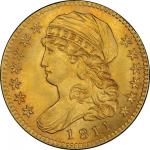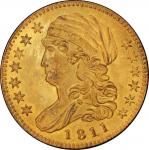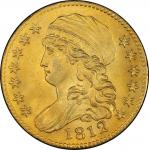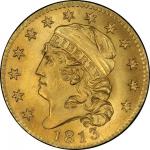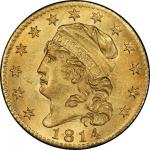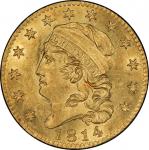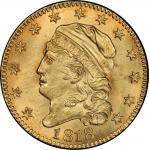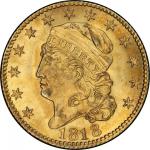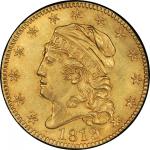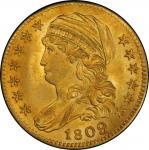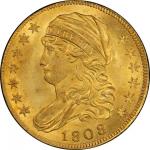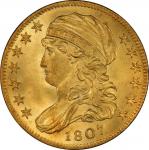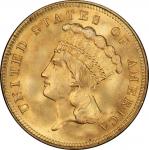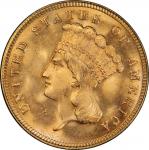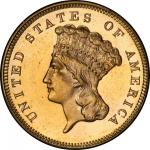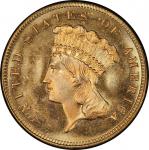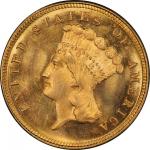“The piece is not likely to drop below the level of high R-7 for a long time to come, as I have been hunting examples of this rarity for twelve years. I first learned that it was a rarity when I found no auction records aside from Earle’s in indexing American auctions for ANS back in 1951. That neither Clapp nor Boyd owned one was confirmation. It is another important naked-eye type.” — Walter Breen, Early United States Half Eagles 1795-1838, 1966. Attractive medium yellow gold toning hides traces of coppery color around some obverse design elements but reveals a wealth of rosy highlights around the reverse periphery. Lightly reflective on both sides, this piece retains good luster for the grade, more prominent on the satiny reverse. A scattering of light marks and lines are seen, numerous though none are severe or disfiguring, consistent with the grade assigned. The largest mark is below UN of UNITED. Some microscopic raised spalling is seen outside of the olive leaves, and another much larger raised artifact is present near the end of the upper pair of leaves. A field of light depressions or pits is noted above the eagle’s head and below MER of AMERICA, probably the result of fine dust or grindings present on the die. Some similar granular surface is noted near the inside points of stars 12 and 13. The strike is sharp on the obverse, though the center of stars 4 and 7 through 9 are flat; star 11 is nearly an outline. Parallel adjustment marks span much of the upper reverse, though the striking force was sufficient to obliterate them most places. They remain visible amidst the fields of microscopic pits and on either side of the wingtip at left. Some lines underlying STATES are nearly perpendicular, oriented horizontally. Struck from an interesting and unpublished die state, this piece lacks the obverse crack that later nearly bisected the die and spelled the demise of this famously elusive die combination. The usually seen crack under the bust is present, very faint from the bust tip to the point of the flag of the first 1 and across that numeral to the top of the adjacent 8. A heavier crack picks up on the right side of 8 and crosses 10 near but below their highest points, then connects through all the stars on the right side of the obverse. Another short thin crack joins the bases of 18 of the date. On the reverse, a crack that begins at the upper left serif of U of UNITED does not yet connect through the tops of UNITED, though a fragile crack seems to connect NI. Starting from U, the crack is barely visible as it crosses the lower two pairs of olive leaves, crosses 5 at its midpoint, D near its top, and ICA near their bases. A light crack joins RI near their midpoints and another runs between ER above their lower serifs. In a later state, all of UNITED is connected to the denomination and all of AMERICA. A thin crack connects OF at their tops. This die state comes after the Bass-Dannreuther state a/a but before b/b. A famous rarity in the series, the 1810 Small Date, Small 5 has long been sought by specialists. Old-time dealers like Paul Nugget recall when this was thought to be the most elusive of the four 1810 varieties. In more recent times, the Large Date, Small 5 has been found to be rarer, but this variety remains both elusive and popular. This is the only Mint State specimen ever graded by PCGS, placing it as perhaps the finest of the small number known, likely fewer than 20 examples. The Harry Bass Core Collection coin is not as nice as this one, while Bass’s duplicate (sold in Bass II as lot 795) was certified as EF-45 (PCGS). An NGC MS-62, sold in the Stack’s sale of June 2008 and the Heritage sale of January 2012, is also inferior. No PCGS-graded coin finer than AU-58 has ever sold at auction. The Auction ’88 coin, cataloged therein as “tied for finest known with a specimen now in a famous Texas collection,” referring to the primary Bass coin, was last seen in the August 2007 Stack’s sale, offered as a PCGS AU-55. That catalog included the most exhaustive census of this variety ever accomplished, compiled by researcher James Matthews, which traced the provenances of at least 12 different specimens and perhaps as many as 17. At the time, this coin had never been seen publicly. This is its first known auction appearance. PCGS# 507595. NGC ID: 25PD.



